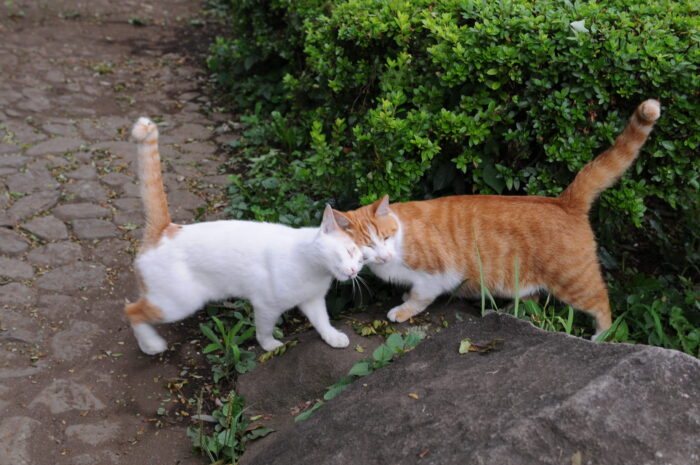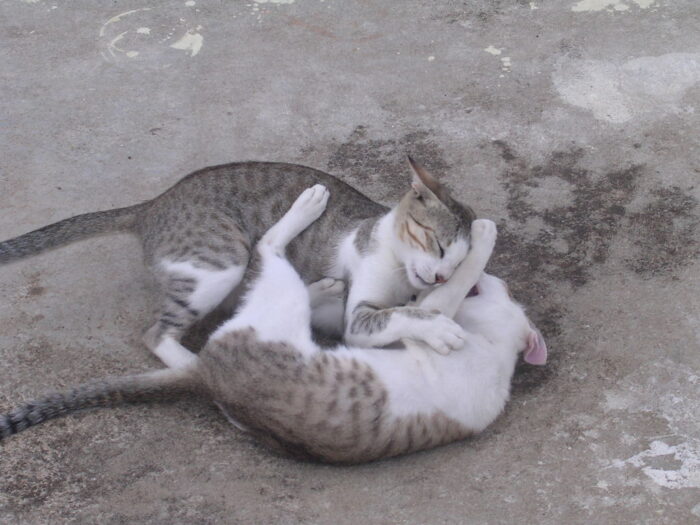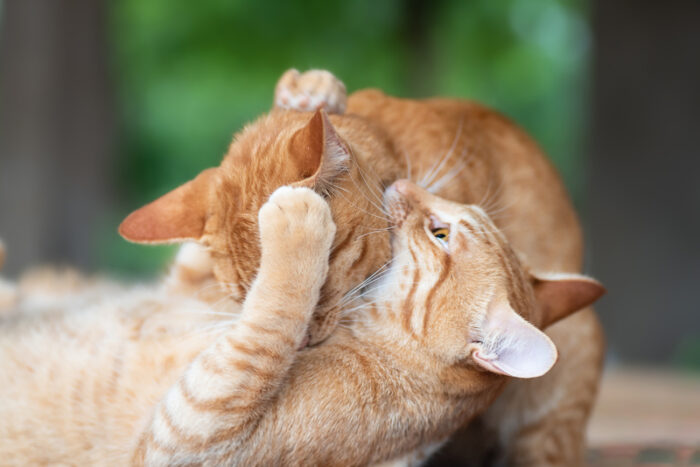It is no secret that cats are full of secrets!
From their super sleeping habits to their aloof nature, it can be difficult for humans to piece together exactly what a kitty is thinking.
But other cats? They definitely know what's going on.
Like many social animals, cats communicate using body and head positions, eye movements, sounds, and even pheromones (chemicals released to send signals to other animals of the same species).
Between cats, these signals are unmistakable. To humans? It is still mystery to be unraveled. But we're trying!
Recently, studies appeared to confirm the long-suspected connection between a cat's eyes and 'smiling'. And now another study is making progress in answering a question that owners of multiple cats have had for ages.
Are my cats fighting or playing?
How rough is too rough?

No issues here! (Wikimedia Commons)
When two or more cats (or any pets) live together, it is always crucial to see that they are getting along. Many animals are territorial, meaning they will guard and protect their space from perceived enemies. So no matter how much you want Snowball and Mr. Jingles to be friends, if one or both of them get it in their head that the other is an enemy, fights are inevitable. And can be serious.
On the other hand, wrestling is a natural and healthy way for cats to interact. This type of play is a good thing, even when it can look wild from the outside.
It is easy to tell a true fight between animals, but what about those moments where the fun just gets a little over the top? When is wrestling fun and when is it something to worry about?
This was what a team of researchers from the University of Veterinary Medicine and Pharmacy in Slovakia and the University of Lincoln in the UK wanted to figure out.
Making a list

How cats observe each other while they are resting is just as important as when they are in contact. (Wikimedia Commons)
To do this, they put together something called an ethnogram. This is a list of behaviours that can be used to study an animal species. Their cat ethnogram featured six groups of behaviours.
- Inactive: This is when kitty is just chilling in a position, like a crouch or a loaf (cat owners, you know the loaf!)
- Wrestling: Cats are in physical contact, pushing, shoving, and tangling
- Chasing: Cats are either pursuing or running away
- Interactive: These are gestures or movements directed toward the other, including grooming or approaching
- Non-interactive: These are gestures or movements toward themselves, like self-cleaning or drinking
- Vocalization: Yowls, growls, hisses, and meows
Watching for these behaviours, the researchers then observed 105 videos of 210 cats interacting with each other. That's a lot of cats!
Which cats did what when? What was their behaviour like? Did they do certain things when playing that they didn't do when fighting?
The results

Clues to what is a fight and what is play can be found in the sounds that cats make, as well as other body postures. (Wikimedia Commons)
The researchers found that the cat interactions fell into three types.
About 40 percent were playful. There was wrestling and a lack of vocalization.
Another 32 percent were agonistic. This word means full of tension, aggression, and conflict. But that doesn't mean it was non-stop fighting. A lot of it featured the cats keeping their distance, displaying aggressive or submissive body postures, and simply doing very little with each other.
The final 28 percent was called intermediate. These were sort of playful, but also had long periods of separation and inactivity.
So what does this mean?
Basically, cats that wrestle a lot are probably best buddies! This is especially true if they don't vocalize (hiss or growl) while they wrestle. Why? Because cats don't want physical contact with another kitty they don't like. Frequent wrestling is actually a sign that they're cool with each other.
On the other hand, cats that vocalize to each other often and keep a lot of distance are probably fighting. They are sending messages of "Hey you! Keep your distance, we're not buds."
And what about chasing? Chasing is not a problem as long as it is mutual (both are doing it to each other). In this way, it's similar to wrestling and is a type of play. But if one kitty is constantly chasing the other away, that could suggest conflict.
The study concluded that the 'intermediate' interactions are toughest to read because they could go either way: be playful or turn into conflict. This is where owners of multiple cats need to keep an eye on their pets and look for clues.
Just like people, animals lead complex lives!
 "I got you, buddy!" "No, I got you!" Are these cats buddies? (ID 122160327 © Buppha Wuttifery | Dreamstime.com)
"I got you, buddy!" "No, I got you!" Are these cats buddies? (ID 122160327 © Buppha Wuttifery | Dreamstime.com)









